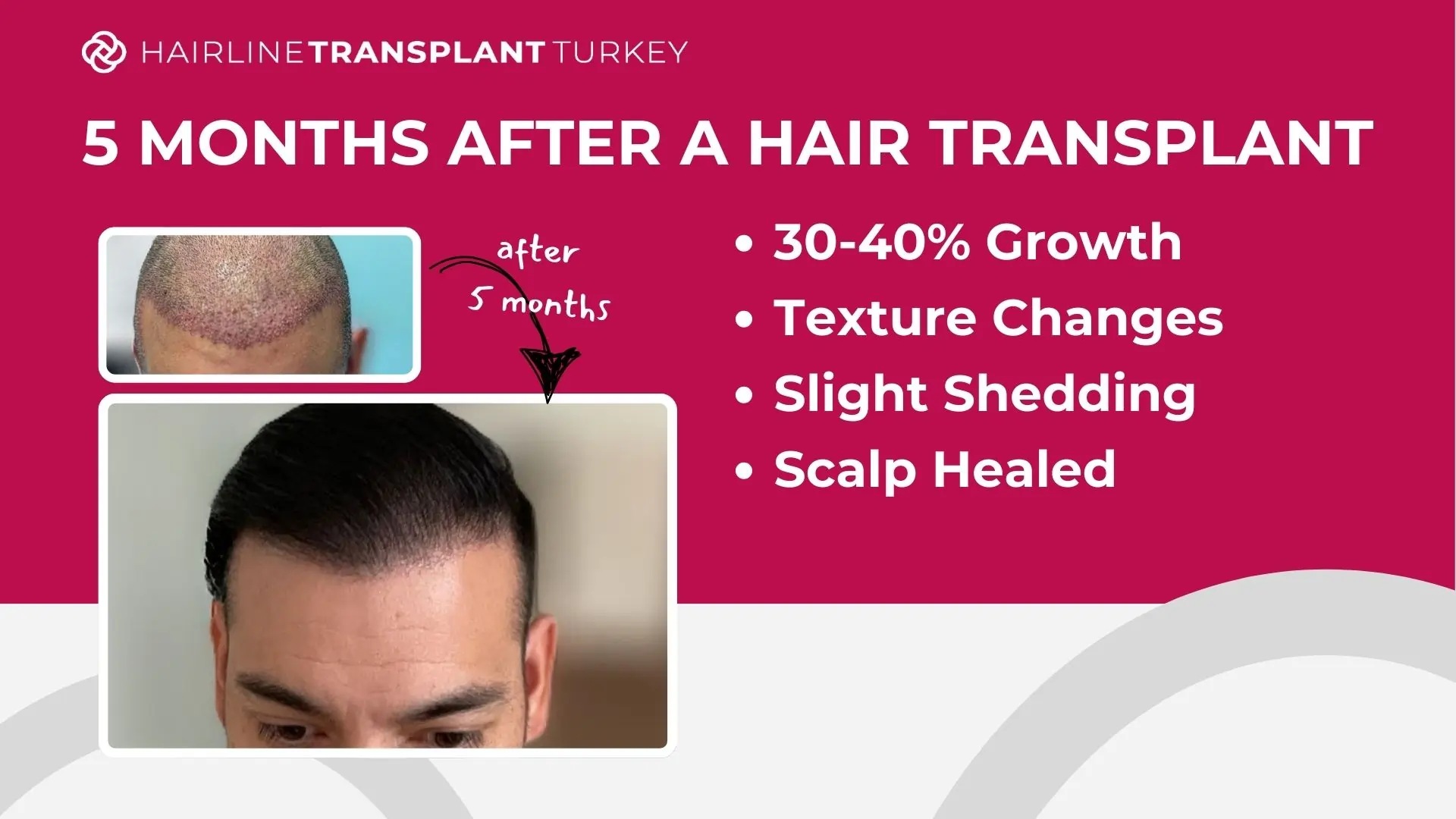5 Months After a Hair Transplant

Welcome to the five-month mark of your hair transplant journey! By now, you’re likely seeing changes in your hair’s growth and texture. 5 months after hair transplant is an exciting time, with visible improvements bringing you closer to your desired look. However, hair restoration is a gradual process, and there’s more progress to come.
Inside this Guide
We’ll explore what typically happens 5 months after a hair transplant, how to nurture your growing hair, and what you can anticipate in the upcoming months. Plus, we’ll provide expert tips to help you maximize your results and make the most of your hair restoration journey.
Curious about your progress? Let us guide you through this phase and help you stay on track with personalized advice and support.
5 Months After Hair Transplant: What’s Happening?
At the five-month mark, your transplanted hair follicles are firmly embedded in your scalp, and you’re likely seeing tangible results. New hair growth should be apparent, although it may still be fine and not yet at its full density. Let’s see what to expect during this stage.

Here’s what to expect at the 5-months after hair transplant mark:
It’s important to remember that hair transplants take time to show full results—you’re just getting started! Most patients see significant hair growth after 3 to 6 months, and the final results become visible around 12 months or more.
How to Care for Your Hair at 5 Months
Your hair is in a delicate phase of growth, and how you care for it will have a significant impact on your final results. Here’s a comprehensive care guide for your hair at five months post-transplant:
Be Gentle with Your Hair and Scalp
At five months, your transplanted follicles are still maturing, so it’s crucial to treat your hair with care. Avoid excessive brushing, pulling, or harsh styling techniques that could strain the hair or cause breakage. Opt for a wide-tooth comb to detangle your hair gently, and always start from the ends, working your way up to the roots.
When shampooing, use your fingertips to gently massage the scalp, which can improve circulation and support hair growth. Stay away from overly aggressive massaging or scrubbing, which could irritate the scalp and disrupt the healing process.
Continue Using Gentle Hair Products
Your hair transplant aftercare routine should still focus on gentle, nourishing products that protect your scalp and hair. Use a sulfate-free shampoo to cleanse your hair without stripping it of natural oils, and follow up with a moisturizing conditioner to keep your hair hydrated and healthy. If you have color-treated hair or your scalp is dry, consider using a leave-in conditioner for added moisture and protection.
Be cautious about introducing any new styling products, as some ingredients—like alcohol or sulfates—can dry out your hair and scalp. Stick to products that are free of harsh chemicals and designed for sensitive scalps.
Limit Heat and Chemical Styling
Your hair may still be fragile at this stage, so it’s best to minimize heat styling, like blow-drying, flat ironing, or curling. Excessive heat can weaken your hair, leading to breakage or stunted growth. If you must use heat tools, always apply a heat protectant spray and use the lowest possible heat setting.
Additionally, avoid chemical treatments such as coloring, perming, or relaxing your hair. These processes can stress the scalp and hair follicles, potentially hindering the growth of your newly transplanted hair. If you’re eager to change your hair color, consult your hair specialist first to ensure it won’t negatively affect your progress.
Maintain a Healthy Diet for Hair Growth
There is a connection between diet and hair transplant success, as proper nutrition supports hair growth and strengthens transplanted follicles. To support the growth of strong, healthy hair, ensure your meals are rich in essential vitamins and minerals. Foods high in biotin, zinc, vitamin D, and omega-3 fatty acids can promote hair growth and improve the overall health of your scalp.
Incorporate leafy greens, eggs, nuts, and fish into your diet to provide your body with the nutrients it needs to nourish your hair follicles. Staying hydrated is also key—drink plenty of water to keep your scalp moisturized and healthy.
Hair Transplant After 5 Months Pictures
What to Expect Moving Forward: The Next Phases
As you look ahead, here’s what you can expect from your hair transplant journey in the months following the five-month mark:
Dealing with the Emotional Side of Recovery
The emotional journey of a hair transplant is often overlooked but is just as important as the physical recovery. At five months, many patients may feel a mix of emotions—excitement from seeing new growth, yet frustration due to the hair not reaching full density. This period can feel challenging, especially if progress seems slower than expected and if you’re experiencing hair transplant shedding after 5 months, but rest assured, these feelings are normal.
Here are some tips for managing the emotional ups and downs during this stage:
Stay Patient: Hair growth takes time, and 5 months after a hair transplant, the journey is still unfolding. Remind yourself that the process is gradual, and full results typically take up to a year or more.
Stay Informed: If you’re feeling unsure or anxious about your progress, don’t hesitate to reach out to your surgeon or hair specialist. A quick consultation can provide reassurance and help clarify what to expect in the coming months.
Celebrate Small Wins: Even though you may not have achieved full density yet, take time to appreciate the milestones along the way. Every bit of new growth is a step closer to your final results. Keep focusing on the progress you’ve made!
Maximize Your Results for the Best Outcome
At five months post-transplant, you’re well on your way to achieving the full, natural-looking hair you’ve been dreaming of. With proper care, patience, and the support of our specialists, your journey will continue to progress smoothly.
Here’s how you can help your new hair thrive:
Your Hair Growth Journey Continues
The 5-month mark after a hair transplant is a crucial stage of your journey. At this point, you are getting closer to seeing your result and dream look. The process is gradual, and the best is yet to come.
As you wait for your new hair to grow in, focus on caring for your scalp, staying positive, and following your surgeon’s advice.
Frequently Asked Questions
Five months after a hair transplant, you can expect noticeable hair growth as the transplanted follicles begin to mature. While some areas may still be thinning, many patients see improved density and texture. It’s normal for hair to appear finer initially, but over the next few months, it should continue to thicken and blend in with your existing hair. Patience is key, as full results typically take 12 to 18 months to achieve.
Yes, it’s completely normal! At five months, the transplanted hair is still in the early stages of growth. Over the next few months, you’ll see the hair thicken and gain more volume.
While you can begin styling your hair, be mindful of using gentle methods and avoiding excessive heat or chemicals. Your hair is still maturing and should be treated with care to ensure optimal growth.
Regular check-ins with your specialist are recommended to monitor your progress and address any concerns. Your specialist can provide personalized advice on how to care for your hair moving forward.
Yes, it’s common for hair to still appear thin at 5 months. The hair is in the early stages of thickening and maturation. Continue to be patient, as the hair follicles will gradually produce thicker strands in the coming months.
Results at 5 months typically include visible new hair growth and improved density in the transplanted areas. While the hair may still be finer and lighter, this is a sign that the transplant is taking effect and that the hair is transitioning from the initial stages of growth.
Some hair shedding can occur around the 5-month mark, which is a normal part of the hair growth cycle. This shedding is usually temporary and is followed by new, thicker hair growth. If you notice excessive shedding or other concerns, consult with your specialist for personalized advice.
At 5 months post-hair transplant, it’s common for patients to experience less density than expected. This is because hair growth is still in the early stages, and the newly transplanted follicles are just starting to mature. Hair may initially appear thin or patchy. However, if you experience no density at all or if you’re worried, you should reach out to your clinic’s aftercare specialist or seek a second opinion.
